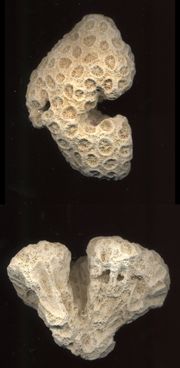Live rock is a term used in
aquaria to describe rock from the ocean introduced into
a
salt water aquarium, which confers to the closed marine
system muliple benefits desired by the salt water marine
hobbyist. The name sometimes leads to misunderstandings as
"live rock" is itself not actually alive, but is made simply
from the calcium carbonate skeletons of long dead corals, or
other calcareous organisms, which in the ocean form the
majority of coral reefs. When taken from the ocean it is
usually encrusted with Coralline and inhabited by a multitude of marine
organisms. The many forms of micro and macroscopic marine
life that live on and inside of the rock, and which acts as
an ideal habitat, give it name "live rock."

Bleached coral skeletons, which can be inhabited
by micro- and macro-organisms to form live rock
Purpose of Live Rock
For the
aquarium trade this rock is highly valued not only for
the diversity of life it can bring to the closed marine
environment, but its function as a superior biological
filter that hosts both aerobic and anaerobic nitrifying
bacteria required for the nitrogen cycle that processes
waste. Live rock becomes the main biological nitrification
base or biological filter of a saltwater aquarium.
Additionally, "live rocks" have a stablizing effect on the
water chemistry, in particular on helping to maintain
constant pH by release of calcium. Lastly, live rock,
especially when encrusted with multiple colors of coralline
algae, becomes a major decorative element of the aquarium
and provides shelter for the inhabitants. It's often used to
build caves, arches, overhangs, or other structures in the
tank, an art known as
aquascaping.
Live rock is harvested for use in the aquarium trade from
collections in the wild near
reefs, where parts may become detached from the main body of
coral by storms. Or it may be from small coralline rocks
which are "seeded" by an aquaculturalist in warm ocean
water, to be harvested later. Live rock can also be seeded
by adding base rock to an active reef aquarium that already
has live rock. Live rock harbors a wide variety of corals,
algae, sponges, and other invertebrates, when they are collected. Not all of these
are desirable, and through a process known as curing,
live rock is usually kept in dark, closed lid tank for
several weeks where most of the life on the rock, which
would not survive in an aquarium, dies off. During this time
there is also attempt to remove all undesirable animals,
often hiding in the rock, before its placed in a display
aquarium. Corals added later will often be attached to live
rocks.
There are different types of live rock. In J. Charles
Delbeek's article "Your First Reef Aquarium", published in
Aquarium USA in 1994, under the Live Rock section he refers
to "reef rock" basically as pieces of coral or coral rock
from outside the reef that have broken off and fallen to the
bottom that then becomes covered with encrusting organisms,
such as coraline algae and sponges. "Inshore rock" Delbeek
refers to as rock from inside the reef that has a tendency
to be more dense and becomes covered with macroalgae, clams,
mussels, crabs, shrimps, and other unwanted organisms. In
Delbeek's view, this more pourous reef rock is preferable to
the more dense inshore rock because it cycles an aquarium
more quickly.
Explaining the purpose live rock in an aquarium, Delbeek:
"The use of live rock immediately introduces into the
aquarium numerous algae, bacteria and small invertebrates
all of which contribute to the overall quality of the
aquarium water. Live rock has just as much, if not more,
surface area for bacteria than a trickle filter. Since live
rock in the aquarium contains various types of bacteria,
algae and corals, waste products such as ammonia, nitrate
and phosphate can have a number of fates. Ammonia, nitrate
and phosphate are readily assimilated by algae and
photosynthetic corals growing on and in the rock. Ammonia
can also be quickly converted into nitrate by the bacteria
on and in the rock. This nitrate can be either absorbed by
the algae and corals, or it can be denitrified by bacteria
in close proximity to the nitrate producing bacteria."
[1][[sv:Levande savannah ]]




